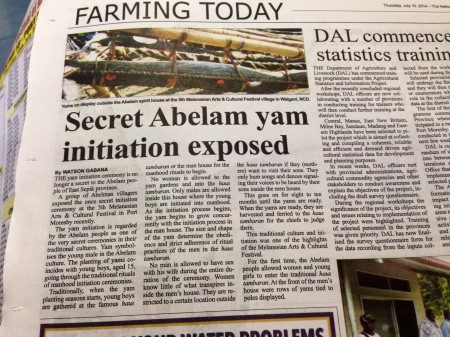I ran across an interesting article in The National newspaper last week in PNG, but I can’t find it online, so I’m posting a scan of it below. You should be able to read it ok if you click on it. It’s worth it. How can anything with the title “Secret Abelam yam initiation exposed” not make for fascinating reading.
The Abelam people are from East Sepik province and their life — especially the life of the men — revolves around yams:
Among the Abelam, the yam cult is a unique cultural institution and the focus of male existence. It involves men striving to produce long tubers (up to a length of 6 feet/180 cm or more), in intense competition with a long term partner in a neighbouring village. There are two major ritual cycles in Abelam life, both centred on this cult — initiation ceremonies which instruct young men in the magic and skills required to grow the prized long yams, and yam growing ceremonies and rituals designed to ensure the success of the current crop.
There are also yam festivals after harvest:
The actual yam displays are very festive occasions. Yam growers from rival villages generally arrive together on the morning of the event. When they are all gathered, the yams, which have been concealed behind barriers and decorated with shell, feather, and basketry ornaments, are carried onto the ceremonial ground. Each waapi is attached to a pole, and carried by two men, one at each end. As the yams are paraded, guests show their approval of their rivals’ efforts by putting special leaves (naarendu) or lime on particularly good specimens. Subsequently the waapi are lined along wooden frames in front of the ceremonial houses where they are carefully inspected and measured by ritual exchange partners. Following the inspection, rivalrous songs, particularly on the themes of yam exchanges and warfare, are sung by individuals. Groups and individuals may claim victory in these song contests by virtue of “evidence” and superior oratory.
It all sounds very spectacular. And extremely important:
…ceremonial yams have an important political function: to a large extent, male status, prestige, and power are dependent on the size and quality of ceremonial yams grown.
In addition to their importance in the political arena, “long yams” have considerable expressive content. Since all yams are propagated vegetatively, yams also form a link between living Abelam men and their ancestors, who planted genetically identical yams. Abelam often invoke their ngwaalndu (clan ancestral spirits) when growing and tending yams. The link between a man, his ceremonial yams, and his ngwaalndu is very close. Yams are of paramount social, symbolic, and religious importance to the Abelam people.
The species involved are Dioscorea alata (waapi) and D. esculenta (jaambe). These are under pressure in some parts of Papua New Guinea, being replaced by recently introduced African species, which seem to withstand pests, diseases and drought somewhat better, I was told. This doesn’t yet seem to be the case for the Abelam, but I wonder for how long. Maybe aeroponics is the answer?

Luigi: Dioscorea is an interesting test of the `introduced crops do better’ idea, the basis of which is that introduced crops escape their co-evolved pests and diseases. Of course, for Dioscorea, this is difficult, as at least the genus (but not each individual species) has a pan-tropical natural distribution with domestication of three continents. But if the indigenous D. alata in PNG is being replaced by African yams in PNG, it flourishes as an introduction as the “most popular yam in the eastern Caribbean” [Purseglove].
I am working in the province in East Sepik and I am monitoring the spread of the white yam amongst our people. It D. rotundata has not been accepted, 29 yrs since its introduction into the Abelam Ceremonial Yam Collection.
It is more for the food security need that there is adoption among the Sepiks, less so than in other parts of PNG.